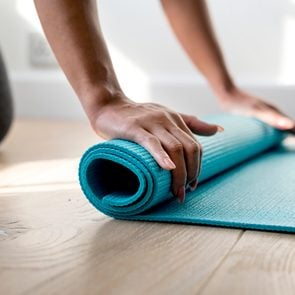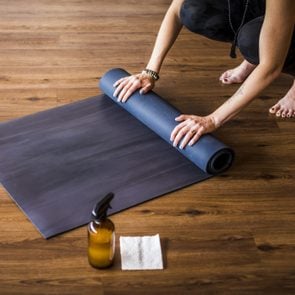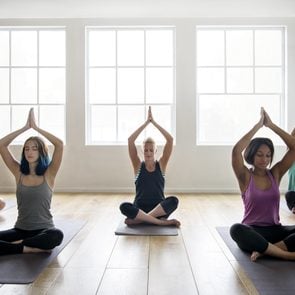8 Top Eco-Friendly Yoga Mats
Updated: Mar. 14, 2022
A good-quality yoga mat can take your practice to the next level. Here's a guide to choosing eco-friendly options that also meet your needs.
Our editors and experts handpick every product we feature. We may earn a commission from your purchases.
The importance of choosing a yoga mat
Whether or not you consider yourself a yogi, if you’re someone who enjoys participating in a yoga class, be it in-person or virtual, you’re going to need at least one trusty piece of equipment: a yoga mat.
Luckily, there is no shortage of options on the market, covering all varieties, including sticky yoga mats, rubber yoga mats, cotton, and hemp yoga mats and even travel yoga mats.
When shopping for a yoga mat, one important factor to keep in mind is whether or not it is considered “eco-friendly.”
“If a yoga mat is eco-friendly, it means that it will eventually break down and biodegrade, as opposed to other mats that can last on the planet for extremely long periods of time, and may even off-gas harmful chemicals from the manufacturing,” explains Amy Ippoliti, yoga teacher, author of The Art and Business of Teaching Yoga, earth activist and founder of Vesselify School of Yoga.
Why buy an eco-friendly yoga mat?
Selecting yoga mats made from sustainable materials helps to reduce the waste that has negative impacts on our planet, explains Katie O’Hara, conservation manager at Loggerhead Marinelife Center in Juno Beach, Florida.
“Unfortunately, yoga mats that aren’t made sustainably contribute to our planet’s growing waste problem, and can even emit toxic gas while being used, which is harmful for consumers’ health,” she says.
“One might think yoga mats made from recycled plastics are a good option, but in reality, they are not truly eco-friendly due to the nano and microplastic pieces that are released during the production into the environment, which are harmful to animals and people.”
“Many are made from polyvinyl chloride (PVC) that contain volatile organic compounds (VOCs) and polycyclic aromatic hydrocarbons (PAHs),” says Paula Jasinski, yoga practitioner, environmental scientist, president and director of science communications for Chesapeake Environmental Communications, and founder of Green Fin Studio in Richmond, Virginia.
“Who wants to rest in child’s pose knowing they’re getting a dose of formaldehyde, phthalates, and other toxic chemicals?” Jasinski asks.
Another reason to buy an eco-friendly mat is the peace and mind of knowing that when you’ve used your mat to its fullest.
In other words, it will biodegrade and return to the earth instead of sticking around forever. “Our planet is dangerously over-saturated with plastics—buying an eco-friendly mat is a responsible thing to do,” Ippoliti adds.
In terms of enhancing your practice, Rachel Welch, certified health coach, yoga instructor, and founder of the post-natal fitness method Revolution Motherhood, notes that you can feel the difference in texture in an eco-friendly yoga mat, as well as the traction under your feet and hands.
She also adds that you can almost always notice a difference in smell, which the eco-friendly mats have no unpleasant odor.
(Here are some yoga quotes to inspire you on your journey.)
What to look for in an eco-friendly yoga mat
When shopping for an eco-friendly yoga mat, here are some qualities that experts recommend looking for.
Biodegradable: In order for your yoga mat to be considered “eco-friendly,” it has to be biodegradable, meaning it will eventually break down and return to the earth.
“The trick is to find a mat that will break down, but also remain durable and sticky for its time with you,” shares Ippoliti.
Non-toxic: Believe it or not, there are many yoga mats out there made with hazardous chemicals, including PVC. Non-toxic yoga mats are made out of natural ingredients, such as plant fiber or cork tree bark, notes Ippoliti.
Odorless: Any eco-friendly yoga mat you purchase should not have any chemical smell to it.
“A lot of synthetic mats can carry a plastic-like smell, especially when you begin sweating on them,” notes Welch.
If you notice this kind of smell, chances are, your yoga mat is not eco-friendly or non-toxic.
Feel and texture: It’s important that you like the feel and the texture of any yoga mat you purchase, even eco-friendly options.
Welch prefers a thin mat that allows her to feel the floor or ground underneath.
“I also want good traction when I’m sweating, so I want something with some patterning built-in,” she adds. (These yoga moves will help you get in shape fast.)
Best eco-friendly yoga mats
Ready to shop eco-friendly yoga mats? Here are some of the best products on the market. (Don’t forget to clean your yoga mat too—here’s how.)
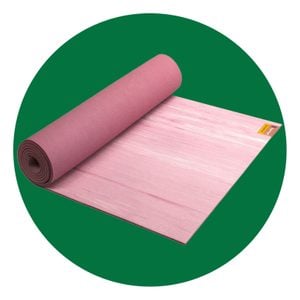
Hugger Mugger Para Rubber Yoga Mat
This yoga mat from Hugger Mugger has all of the bells and whistles you’re looking for and it’s eco-friendly on top of it all.
It has a ¼” thickness and features two sides that provide varying degrees of grippy textures—one that’s covered in tiny rubber bumps to keep you in place and one that has a woven-like rubbery grip that’s ideal for hot yoga.
It is made out of eco-friendly natural rubber (which of course means you shouldn’t choose this one if you have a latex allergy).
(Find out if chair yoga is the miracle cure for arthritis pain.)
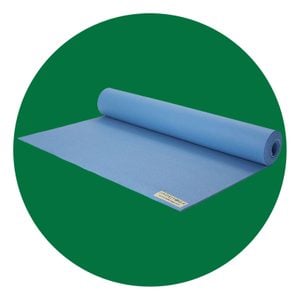
JadeYoga Harmony Mat
If you’re looking for a thicker mat that provides a bit more cushion for your knees, this is a great option from JadeYoga.
Welch finds it particularly useful for when she’s practicing outside on a deck or on hard ground.
Made out of natural rubber, JadeYoga mats are free from plastic, including PVC, and are non-toxic.
It’s also worth adding that the company donates $5 to various causes depending on which color Harmony Mat you buy.
(Start your day off with these morning yoga stretches.)
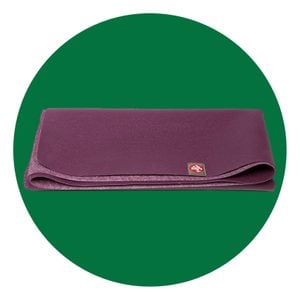
Manduka eKO Superlite Yoga Travel Mat
This Manduka yoga mat is popular for so many reasons, but one of the most important to so many yogis is the fact that it is eco-friendly and made out of 100 percent natural tree rubber with foaming agents that are entirely non-toxic and free of azo dyes.
It is, however, worth noting that this mat is on the thinner side, but many appreciate this feature since it makes it easier to travel with.
One thing it doesn’t compromise on is grip—it has excellent traction and it prevents sweat from sticking to it. As with any yoga mat, Ippoliti warns never to leave this mat in a sunny window or a hot car. “They do dry out and lose their stickiness,” she says.
Here’s a 10-minute yoga workout you can do every day.
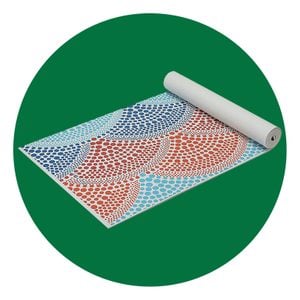
Gaiam Yoga Mat
Gaiam is one of the most popular yoga brands, as they sell all sorts of products from mats to accessories.
One of their key pillars is their dedication to sustainability, which can be seen in the products they produce.
This mat is also PVC-free and made out of natural rubber. Even their blocks are made from 100 percent recycled materials (cork to be specific).
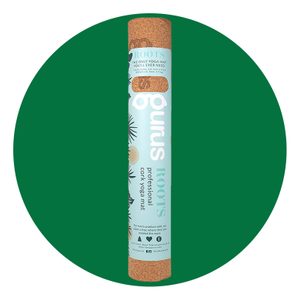
Gurus Roots Cork Yoga Mat
You can tell by just looking at this mat that it has a lot to offer in terms of sustainability. It features a natural tree rubber bottom layer and a waxy, cork coating on its top layer that prevents it from absorbing moisture and helps it maintain a strong grip.
“The cork is absorbent and naturally antimicrobial, making it a good choice for hot yoga sessions,” says Jasinski. It’s worth noting that this mat from Gurus is heavier than most yoga mats, weighing in at about five pounds.
(This yoga routine may lead to better digestion.)
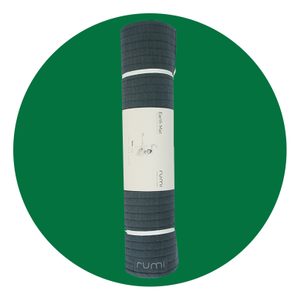
Rumi Earth Yoga Mat
This yoga mat from Rumi features a woven cotton top layer and a natural rubber-coated bottom layer which both allow it to maintain a comfortable grip and texture that doesn’t disturb you in any of your positions. It’s entirely biodegradable and 100 percent machine washable, which is a hard-to-come-by feature in a yoga mat.
(Here are 7 reasons why your child should be practicing yoga.)

Atmananda Black Yoga Mat
If you’re someone who’s just starting out on your yoga journey, you’ll appreciate the fact that this Atmananda yoga mat comes clad with alignment markers that help you see exactly where your hands and feet should go in various yoga positions.
It’s also eco-friendly, made out of 100 percent rubber, and without toxic chemicals.
(Here’s what might happen when you start doing yoga.)
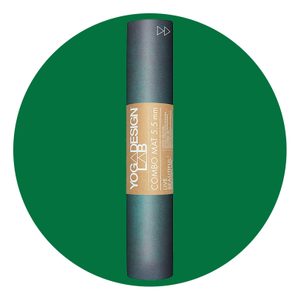
Yoga Design Lab Combo Mat
Heidi Kristoffer, creator of the CrossFlow Yoga app, is a huge fan of this yoga mat from Yoga Design Lab, which also doubles as a yoga towel.
“These mats are made from biodegradable, recyclable, 100 percent natural tree rubber base,” she says.
Pro tip: Since these mats are made for sweating, she recommends bringing them to any hot yoga or sweaty flow class.

